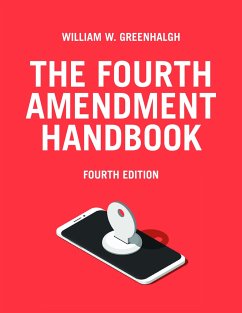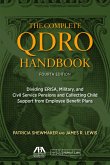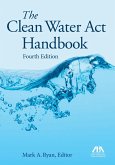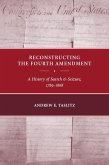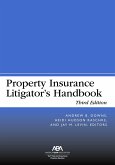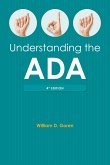William W Greenhalgh
The Fourth Amendment Handbook, Fourth Edition
William W Greenhalgh
The Fourth Amendment Handbook, Fourth Edition
- Broschiertes Buch
- Merkliste
- Auf die Merkliste
- Bewerten Bewerten
- Teilen
- Produkt teilen
- Produkterinnerung
- Produkterinnerung
This handbook is the definitive guide to understanding Fourth Amendment case law. With summaries of all Supreme Court Fourth Amendment decisions through January 2019, the book is an excellent reference on the evolving history of the Fourth Amendment. This newly updated and revised chronological survey serves as a starting point for research, a quick means of review, or a checklist in court. The Handbook is an invaluable resource for any lawyer presented with an issue involving search and seizure.
Andere Kunden interessierten sich auch für
![The Complete Qdro Handbook, Fourth Edition The Complete Qdro Handbook, Fourth Edition]() Patricia D ShewmakerThe Complete Qdro Handbook, Fourth Edition175,99 €
Patricia D ShewmakerThe Complete Qdro Handbook, Fourth Edition175,99 €![The Clean Water ACT Handbook, Fourth Edition The Clean Water ACT Handbook, Fourth Edition]() The Clean Water ACT Handbook, Fourth Edition176,99 €
The Clean Water ACT Handbook, Fourth Edition176,99 €![Reconstructing the Fourth Amendment Reconstructing the Fourth Amendment]() Andrew E TaslitzReconstructing the Fourth Amendment38,99 €
Andrew E TaslitzReconstructing the Fourth Amendment38,99 €![Discovery Problems and Their Solutions, Fourth Edition Discovery Problems and Their Solutions, Fourth Edition]() Paul W GrimmDiscovery Problems and Their Solutions, Fourth Edition117,99 €
Paul W GrimmDiscovery Problems and Their Solutions, Fourth Edition117,99 €![Property Insurance Litigator's Handbook, Third Edition Property Insurance Litigator's Handbook, Third Edition]() Property Insurance Litigator's Handbook, Third Edition222,99 €
Property Insurance Litigator's Handbook, Third Edition222,99 €![Understanding the Americans with Disabilities Act, Fourth Edition Understanding the Americans with Disabilities Act, Fourth Edition]() William D GorenUnderstanding the Americans with Disabilities Act, Fourth Edition118,99 €
William D GorenUnderstanding the Americans with Disabilities Act, Fourth Edition118,99 €![Handbook, Fourth International Convention, Student Volunteer Movement for Foreign Missions, Toronto, Ontario, February 26 to March 2, 1902 Handbook, Fourth International Convention, Student Volunteer Movement for Foreign Missions, Toronto, Ontario, February 26 to March 2, 1902]() Handbook, Fourth International Convention, Student Volunteer Movement for Foreign Missions, Toronto, Ontario, February 26 to March 2, 190215,99 €
Handbook, Fourth International Convention, Student Volunteer Movement for Foreign Missions, Toronto, Ontario, February 26 to March 2, 190215,99 €-
-
-
This handbook is the definitive guide to understanding Fourth Amendment case law. With summaries of all Supreme Court Fourth Amendment decisions through January 2019, the book is an excellent reference on the evolving history of the Fourth Amendment. This newly updated and revised chronological survey serves as a starting point for research, a quick means of review, or a checklist in court. The Handbook is an invaluable resource for any lawyer presented with an issue involving search and seizure.
Hinweis: Dieser Artikel kann nur an eine deutsche Lieferadresse ausgeliefert werden.
Hinweis: Dieser Artikel kann nur an eine deutsche Lieferadresse ausgeliefert werden.
Produktdetails
- Produktdetails
- Verlag: American Bar Association
- 4th edition
- Seitenzahl: 183
- Erscheinungstermin: 7. Juni 2020
- Englisch
- Abmessung: 277mm x 213mm x 13mm
- Gewicht: 499g
- ISBN-13: 9781641054829
- ISBN-10: 1641054824
- Artikelnr.: 58022925
- Herstellerkennzeichnung
- Libri GmbH
- Europaallee 1
- 36244 Bad Hersfeld
- 06621 890
- Verlag: American Bar Association
- 4th edition
- Seitenzahl: 183
- Erscheinungstermin: 7. Juni 2020
- Englisch
- Abmessung: 277mm x 213mm x 13mm
- Gewicht: 499g
- ISBN-13: 9781641054829
- ISBN-10: 1641054824
- Artikelnr.: 58022925
- Herstellerkennzeichnung
- Libri GmbH
- Europaallee 1
- 36244 Bad Hersfeld
- 06621 890
William W. Greenhalgh was both a professor of law at Georgetown University Law Center teaching Constitutional Criminal Procedure and the director of the Prettyman-Stiller Legal Fellowship Program in the graduate school of the Law Center from 1963 until his death in 1994. In 1974, Prof. Greenhalgh became director of the Criminal Justice Clinic at Georgetown, serving in that capacity until his death. He was widely regarded as a pioneer and champion of clinical legal education. The author of many articles and books, Prof. Greenhalgh was considered a leading authority on the Fourth and Sixth Amendments to the U.S. Constitution.
Dedication iii Foreword vii by Andrew L. Sonner Preface to the Fourth Edition ix Preface to the Third Edition xv Acknowledgments for the Fourth Edition xvii Text of the Fourth Amendment xix Introduction: A Conceptualization of the Fourth Amendment 1 I. The Threshold Applicability of the Fourth Amendment 1 A. Katz and the
Reasonable Expectation of Privacy
2 B. Applicability to Place 3 C. Applicability to the Person of the Searcher 4 D. Applicability to the Person of the Defendant 5 1. Proprietary Standing 5 2. The Rise and Fall of Automatic Standing 5 3. Derivative Standing 5 4. Target Standing and Conspirator Standing 6 5. Who Are
The People
? 6 E. Applicability to Type of Police Conduct 6 1. What Is a
Search
? 7 2. What Is a
Seizure
of Property? 7 3. What Is a
Seizure
of a Person? 7 F. Miscellaneous Applicability 8 II. The Substance of the Fourth Amendment 9 A. The Structure of the Fourth Amendment 9 B. Objective Versus Procedural Reasonableness 9 C. Administrative Searches and Other Searches Serving
Special Needs Beyond the Investigative Norm 10 D. General Reasonableness and the Special Problem of Examining Bodily Fluids for Traces of Drugs and Alcohol 11 E. The Predicate for the Initial Intrusion Versus the Scope and the Manner of Searching 11 F. The Manner of Conducting a Search and the Special Problem of
Knock and Announce
12 G. Probable Cause 13 H. The Special Problem of Temporarily
Seizing
a Residence While Obtaining a Warrant to Search It 14 I. The General Reasonableness Approach Versus the Centrality of the Warrant Requirement Approach 14 J. The Centrality of the Warrant Requirement 15 K. Exceptions to the Warrant Requirement 16 1. Search Incident to Lawful Arrest 16 2. The Carroll Doctrine 17 3. The Suitcase or Container Exception 18 4. Exigent or Emergency Circumstances 18 5. Stop and Frisk 19 6. The Plain View Doctrine (Plus Plain Feel) 20 7. Consent 21 8. What the Police May Do in the Context of a Traffic Stop 21 vi L. The Sui Generis Nature of the Law of Arrest 22 III. The Sanction for a Fourth Amendment Violation 23 A. The Exclusionary Rule 23 B. The
Fruit of the Poisoned Tree
Doctrine 25 IV. Independent State Grounds . . . . . . . . . . . 26 A Chronology of Supreme Court Justices 27 Features of This Book 29 Table of Abbreviations 31 Survey 33 Index 165 Table of Cases 171 About the Authors, Editors, and Contributors 181
Reasonable Expectation of Privacy
2 B. Applicability to Place 3 C. Applicability to the Person of the Searcher 4 D. Applicability to the Person of the Defendant 5 1. Proprietary Standing 5 2. The Rise and Fall of Automatic Standing 5 3. Derivative Standing 5 4. Target Standing and Conspirator Standing 6 5. Who Are
The People
? 6 E. Applicability to Type of Police Conduct 6 1. What Is a
Search
? 7 2. What Is a
Seizure
of Property? 7 3. What Is a
Seizure
of a Person? 7 F. Miscellaneous Applicability 8 II. The Substance of the Fourth Amendment 9 A. The Structure of the Fourth Amendment 9 B. Objective Versus Procedural Reasonableness 9 C. Administrative Searches and Other Searches Serving
Special Needs Beyond the Investigative Norm 10 D. General Reasonableness and the Special Problem of Examining Bodily Fluids for Traces of Drugs and Alcohol 11 E. The Predicate for the Initial Intrusion Versus the Scope and the Manner of Searching 11 F. The Manner of Conducting a Search and the Special Problem of
Knock and Announce
12 G. Probable Cause 13 H. The Special Problem of Temporarily
Seizing
a Residence While Obtaining a Warrant to Search It 14 I. The General Reasonableness Approach Versus the Centrality of the Warrant Requirement Approach 14 J. The Centrality of the Warrant Requirement 15 K. Exceptions to the Warrant Requirement 16 1. Search Incident to Lawful Arrest 16 2. The Carroll Doctrine 17 3. The Suitcase or Container Exception 18 4. Exigent or Emergency Circumstances 18 5. Stop and Frisk 19 6. The Plain View Doctrine (Plus Plain Feel) 20 7. Consent 21 8. What the Police May Do in the Context of a Traffic Stop 21 vi L. The Sui Generis Nature of the Law of Arrest 22 III. The Sanction for a Fourth Amendment Violation 23 A. The Exclusionary Rule 23 B. The
Fruit of the Poisoned Tree
Doctrine 25 IV. Independent State Grounds . . . . . . . . . . . 26 A Chronology of Supreme Court Justices 27 Features of This Book 29 Table of Abbreviations 31 Survey 33 Index 165 Table of Cases 171 About the Authors, Editors, and Contributors 181
Dedication iii Foreword vii by Andrew L. Sonner Preface to the Fourth Edition ix Preface to the Third Edition xv Acknowledgments for the Fourth Edition xvii Text of the Fourth Amendment xix Introduction: A Conceptualization of the Fourth Amendment 1 I. The Threshold Applicability of the Fourth Amendment 1 A. Katz and the
Reasonable Expectation of Privacy
2 B. Applicability to Place 3 C. Applicability to the Person of the Searcher 4 D. Applicability to the Person of the Defendant 5 1. Proprietary Standing 5 2. The Rise and Fall of Automatic Standing 5 3. Derivative Standing 5 4. Target Standing and Conspirator Standing 6 5. Who Are
The People
? 6 E. Applicability to Type of Police Conduct 6 1. What Is a
Search
? 7 2. What Is a
Seizure
of Property? 7 3. What Is a
Seizure
of a Person? 7 F. Miscellaneous Applicability 8 II. The Substance of the Fourth Amendment 9 A. The Structure of the Fourth Amendment 9 B. Objective Versus Procedural Reasonableness 9 C. Administrative Searches and Other Searches Serving
Special Needs Beyond the Investigative Norm 10 D. General Reasonableness and the Special Problem of Examining Bodily Fluids for Traces of Drugs and Alcohol 11 E. The Predicate for the Initial Intrusion Versus the Scope and the Manner of Searching 11 F. The Manner of Conducting a Search and the Special Problem of
Knock and Announce
12 G. Probable Cause 13 H. The Special Problem of Temporarily
Seizing
a Residence While Obtaining a Warrant to Search It 14 I. The General Reasonableness Approach Versus the Centrality of the Warrant Requirement Approach 14 J. The Centrality of the Warrant Requirement 15 K. Exceptions to the Warrant Requirement 16 1. Search Incident to Lawful Arrest 16 2. The Carroll Doctrine 17 3. The Suitcase or Container Exception 18 4. Exigent or Emergency Circumstances 18 5. Stop and Frisk 19 6. The Plain View Doctrine (Plus Plain Feel) 20 7. Consent 21 8. What the Police May Do in the Context of a Traffic Stop 21 vi L. The Sui Generis Nature of the Law of Arrest 22 III. The Sanction for a Fourth Amendment Violation 23 A. The Exclusionary Rule 23 B. The
Fruit of the Poisoned Tree
Doctrine 25 IV. Independent State Grounds . . . . . . . . . . . 26 A Chronology of Supreme Court Justices 27 Features of This Book 29 Table of Abbreviations 31 Survey 33 Index 165 Table of Cases 171 About the Authors, Editors, and Contributors 181
Reasonable Expectation of Privacy
2 B. Applicability to Place 3 C. Applicability to the Person of the Searcher 4 D. Applicability to the Person of the Defendant 5 1. Proprietary Standing 5 2. The Rise and Fall of Automatic Standing 5 3. Derivative Standing 5 4. Target Standing and Conspirator Standing 6 5. Who Are
The People
? 6 E. Applicability to Type of Police Conduct 6 1. What Is a
Search
? 7 2. What Is a
Seizure
of Property? 7 3. What Is a
Seizure
of a Person? 7 F. Miscellaneous Applicability 8 II. The Substance of the Fourth Amendment 9 A. The Structure of the Fourth Amendment 9 B. Objective Versus Procedural Reasonableness 9 C. Administrative Searches and Other Searches Serving
Special Needs Beyond the Investigative Norm 10 D. General Reasonableness and the Special Problem of Examining Bodily Fluids for Traces of Drugs and Alcohol 11 E. The Predicate for the Initial Intrusion Versus the Scope and the Manner of Searching 11 F. The Manner of Conducting a Search and the Special Problem of
Knock and Announce
12 G. Probable Cause 13 H. The Special Problem of Temporarily
Seizing
a Residence While Obtaining a Warrant to Search It 14 I. The General Reasonableness Approach Versus the Centrality of the Warrant Requirement Approach 14 J. The Centrality of the Warrant Requirement 15 K. Exceptions to the Warrant Requirement 16 1. Search Incident to Lawful Arrest 16 2. The Carroll Doctrine 17 3. The Suitcase or Container Exception 18 4. Exigent or Emergency Circumstances 18 5. Stop and Frisk 19 6. The Plain View Doctrine (Plus Plain Feel) 20 7. Consent 21 8. What the Police May Do in the Context of a Traffic Stop 21 vi L. The Sui Generis Nature of the Law of Arrest 22 III. The Sanction for a Fourth Amendment Violation 23 A. The Exclusionary Rule 23 B. The
Fruit of the Poisoned Tree
Doctrine 25 IV. Independent State Grounds . . . . . . . . . . . 26 A Chronology of Supreme Court Justices 27 Features of This Book 29 Table of Abbreviations 31 Survey 33 Index 165 Table of Cases 171 About the Authors, Editors, and Contributors 181

